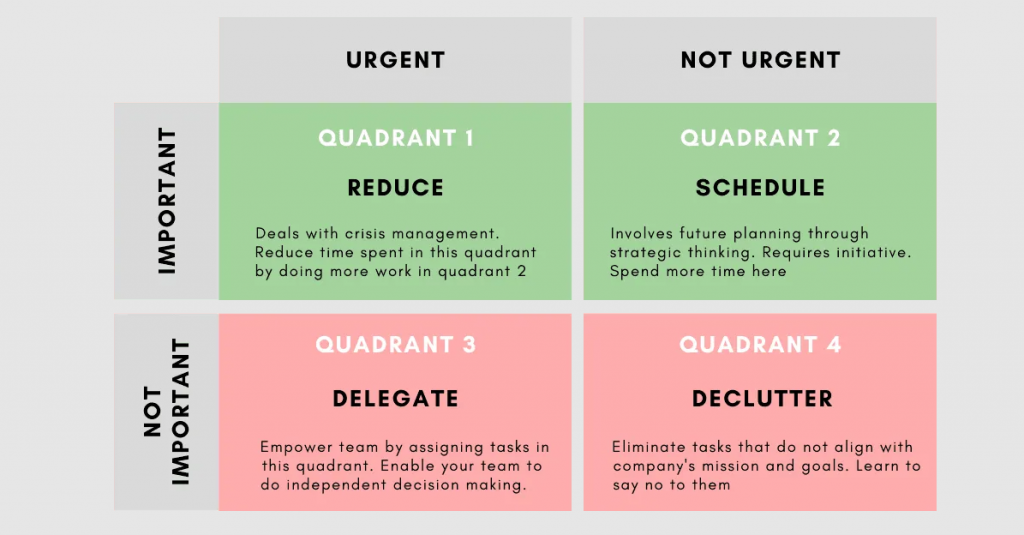For many small business owners, time management can be a real challenge. And if you’re a mom like me – you understand this challenge on a whole other level!
In addition, I often find many entrepreneurs don’t get the results they want because they waste time on things that FEEL urgent or important, but don’t actually move the needle in their business.
It is absolutely vital that you learn to distinguish between important vs. not important and urgent vs. not urgent, and how the combination of those two things should be prioritized.
One powerful tool I learned about a few years back that really helped me prioritize the tasks in my business is the Eisenhower matrix which was created by President Dwight Eisenhower during his presidency as a way to better prioritize tasks on a daily basis.
The Eisenhower matrix breaks down tasks into four quadrants with different priorities:
- Urgent and important
- Urgent but not important
- Not urgent but important
- Not urgent or important at all.
The Eisenhower matrix will help you identify what actually needs your attention and what should be done right now, scheduled, delegated, or deleted.
I like to apply this to my entire life, not just business. Because we are holistic human beings and that means for many of us, we’re helping our kids with homework one second and jumping on a zoom call the next. Our lives are very much integrated these days.
But if it helps at first, try doing this exercise for business, and then your personal life.
If you’re a visual learner, here’s what the Eisenhower quadrant looks like.

Ultimately you should be spending a lot more time in quadrant #2 because working on the important things are often not urgent, yet they actually move the needle in your company.
Examples of Important and Urgent in a startup ecommerce business:
If you’re the only one doing customer service, it might be handling customer tickets as they come in.
If you have regular revenue coming in, I would prioritize hiring and training a customer service person ASAP so I could focus on juggling all the other aspects of the business. This could potentially fall into the Important quadrant, but as soon as you get your business off the ground this task will become urgent because of how time-consuming it is and because customers need to be handled 24/7.
Examples of Important but not Urgent:
This quadrant involves important planning and strategic thinking. This is where you should actually spend most of your time, but many start-up business owners skip these activities or procrastinate until they actually do become urgent.
Tasks in this quadrant would include things like research, product development, taking courses or coaching, reading books, strategic planning, developing systems & processes, personal development, finances, hiring, outsourcing, etc.
Examples of Not Important but Urgent:
These are tasks or things that tend to happen to us — little fires we need to put out constantly — that take our time and need to be addressed, but aren’t strategic or require a CEO brain. The really good news is most of the time, the things that fall into this category can be delegated to a team member, business partner, a Virtual Assistant, or outsourced one way or another.
An example in this quadrant would be, let’s say your email service provider stopped sending emails to your customers because of a tech glitch, that would fall under not important but urgent. This is definitely something that matters and that does affect revenue, but as you grow your business, someone else should be doing this task.
Examples of Not Important, nor Urgent:
This quadrant includes tasks like chronic procrastination (i.e., scrolling on social media), going down rabbit holes researching topics on Wikipedia that will never become relevant to your business or personal life in any way, spending hours on your eCommerce website tweaking the font size and layout.
This is simply a quadrant to help you realize what it is you should DELETE from your schedule and to-dos.
A lot of the time, we get so caught up in tyring to get our business off the ground that we forget to take a step back and evaluate what’s most important.
The Eisenhower Matrix can help you prioritize your tasks by asking yourself “What is urgent?” or “What is important but not urgent?”. What are some ways to overcome this problem?
I recommend using the Eisenhower matrix as an evaluation tool for allocating resources and determining which tasks need attention right away. It also helps keep you from wasting valuable time on unimportant things.
Did you find this enlightening?
What did you realize just by reading this post?
What specific tasks are you going to stop doing and start doing more of?
Share in the comments below!
